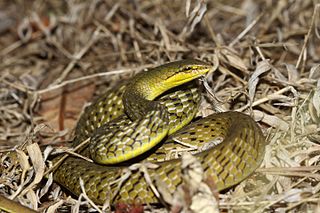
Ahaetulla perroteti, known commonly as the bronze-headed vine snake, Perrotet's vine snake, or the Western Ghats bronzeback, is a species of mildly venomous, rear-fanged snake in the family Colubridae. The species is endemic to the Western Ghats in South India.
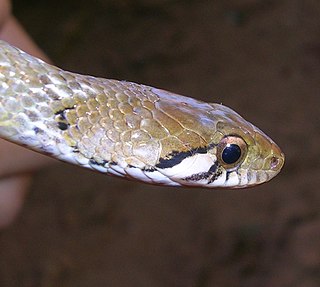
The Nilgiri keelback, also known commonly as Beddome's keelback, is a species of snake found in the Western Ghats in India. The species is named after Richard Henry Beddome, 1830–1911, British army officer and naturalist. It was first discovered near the Nilgiris but is now known more widely from the Western Ghats. This snake is terrestrial and feeds on toads.

The Himalayan keelback is a species of grass snake in the family Colubridae. The species is endemic to South Asia.
Blythia reticulata, commonly known as Blyth's reticulate snake, Blyth's reticulated snake, or the iridescent snake, is a species of snake in the subfamily Natricinae of the family Colubridae of the superfamily Colubroidea. The species is endemic to Asia.
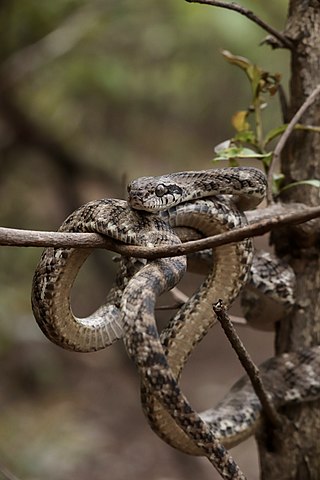
Boiga forsteni, also known commonly as Forsten's cat snake, is a species of mildly venomous rear-fanged snake in the family Colubridae. The species is endemic to South Asia.

Platyceps gracilis, commonly known as the graceful racer or slender racer, is a species of snake endemic to West India.

The white-banded wolf snake, also known as the northern large-toothed snake, is a species of colubrid snake found in Asia.

The trinket snake, also known commonly as the common trinket snake, is a species of nonvenomous constricting snake in the family Colubridae. The species is native to southern Central Asia.
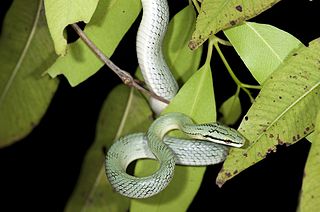
Gonyosoma frenatum, common name Khasi Hills trinket snake, is a species of colubrid snake found in north-eastern India, southern China, Taiwan, and Vietnam.
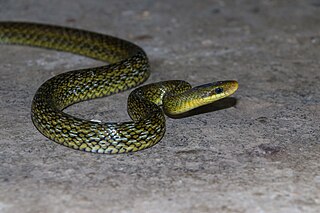
Elaphe hodgsoni, also known commonly as Hodgson's rat snake and the Himalayan trinket snake, is a species of snake in the family Colubridae. The species is native to parts of Asia around the Himalayas.

Oligodon cinereus, the ashy kukri snake or Günther's kukri snake, is a species of snake in the family Colubridae.

Psammophis leithii, commonly called Leith's sand snake, the Pakistani ribbon snake, and the Pakistan sand racer, is a species of rear-fanged, mildly venomous snake in the family Psammophiidae. The species is native to South Asia. It is harmless to humans.

Calliophis nigriscens, commonly known as the black coral snake or striped coral snake, is a species of venomous elapid snake endemic to the Western Ghats, India.
Jerdon's day gecko is a species of gecko, a lizard in the family Gekkonidae. The species is native to India and Sri Lanka.
Uropeltis liura, commonly known as the Ashambu shieldtail and Günther's earth snake, is a species of snake in the family Uropeltidae. The species is endemic to India.

Uropeltis pulneyensis, commonly known as the Indian earth snake and the Palni shieldtail, is a species of snake in the family Uropeltidae. The species is endemic to the Western Ghats of India.
Uropeltis rubrolineata is a species of nonvenomous shieldtail snake in the family Uropeltidae. The species is endemic to southern India. There are no subspecies that are recognized as being valid.

Stokes's sea snake is a large species of sea snake in the family Elapidae. It is sometimes placed in its own genus Astrotia. The species is endemic to tropical Indo-Pacific oceanic waters.

Lytorhynchus is a genus of snakes of the family Colubridae.

Anderson's stream snake, also known commonly as Anderson's mountain keelback, is a species of snake in the family Colubridae. The species is native to Asia


















